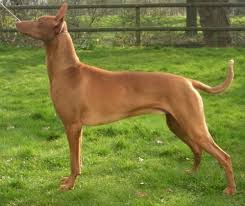
Tesem
Conditions of detention
Tesem dogs were well-suited to the desert environment of ancient Egypt, where they lived alongside their human companions in villages and settlements. They were often kept as hunting and companion animals.
Useful Fact: Their adaptation to hot climates made them excellent hunters in the arid regions of Egypt, and they thrived in environments where they could run and chase prey.
Nutrition and diet
The diet of the Tesem likely consisted of scraps from human meals, including meat and grains, which were common in ancient Egyptian diets. A balanced diet is essential for maintaining their health and energy.
Useful Fact: Providing a diet that includes lean meats and high-quality protein sources helps support their high energy levels and maintains their overall health.
Health
Tesem dogs were generally robust and healthy, adapted to the harsh desert conditions. However, like other sighthounds, they may have been prone to injuries related to their high-speed running.
Useful Fact: Maintaining a healthy weight and ensuring regular exercise helps prevent common sighthound issues such as joint problems.
Grooming and care
Tesem dogs likely had a short, smooth coat that required minimal grooming. Regular brushing helps remove loose hair and keep their coat healthy.
Useful Fact: Their low-maintenance coat made them easy to care for, requiring only occasional baths and regular brushing to maintain cleanliness.
Education and training
Tesem dogs were intelligent and independent, traits that made them excellent hunters. Training would have focused on developing their hunting skills and obedience.
Useful Fact: Positive reinforcement and consistent training help harness their natural hunting instincts and ensure they are well-behaved around people and other animals.
Toys and entertainment
Tesem dogs enjoyed activities that stimulated their minds and bodies, such as chasing and fetching games. Engaging in hunting-related activities would have been highly stimulating for them.
Useful Fact: Providing interactive toys and regular playtime can prevent boredom and channel their natural energy into positive activities.
Safety
Due to their strong prey drive and high energy, Tesem dogs should be kept in a secure area when outdoors to prevent them from chasing wildlife.
Useful Fact: A well-fenced yard is essential to give them the freedom to roam and explore safely without the risk of running off.
Accessories
Sturdy collars, harnesses, and leashes are important for managing the Tesem during training and outdoor activities.
Useful Fact: Using a harness can provide better control and prevent neck strain, especially during walks and running sessions.
Socialization
Tesem dogs were likely loyal and formed strong bonds with their families but could be wary of strangers. Early and consistent socialization is important to ensure they are comfortable in various environments.
Useful Fact: Introducing them to different people, animals, and settings from a young age helps them become well-adjusted and confident adults.
Travel and Transportation
Tesem dogs could travel well if they were accustomed to it from a young age. Ensuring they have a comfortable and secure space in the vehicle is important.
Useful Fact: Using a travel crate or a harness designed for car travel ensures their safety and comfort during trips.
Behavior and psychology
The Tesem was known for its loyalty, intelligence, and strong hunting instincts. They formed strong bonds with their families and were naturally protective.
Useful Fact: Understanding their hunting nature and providing proper training can help manage their behavior and ensure they are confident and well-behaved.
Legal aspects
Owners should comply with general dog ownership laws, such as licensing, vaccination requirements, and leash laws.
Useful Fact: In some areas, there may be specific regulations regarding hunting breeds, so checking local laws is important.


